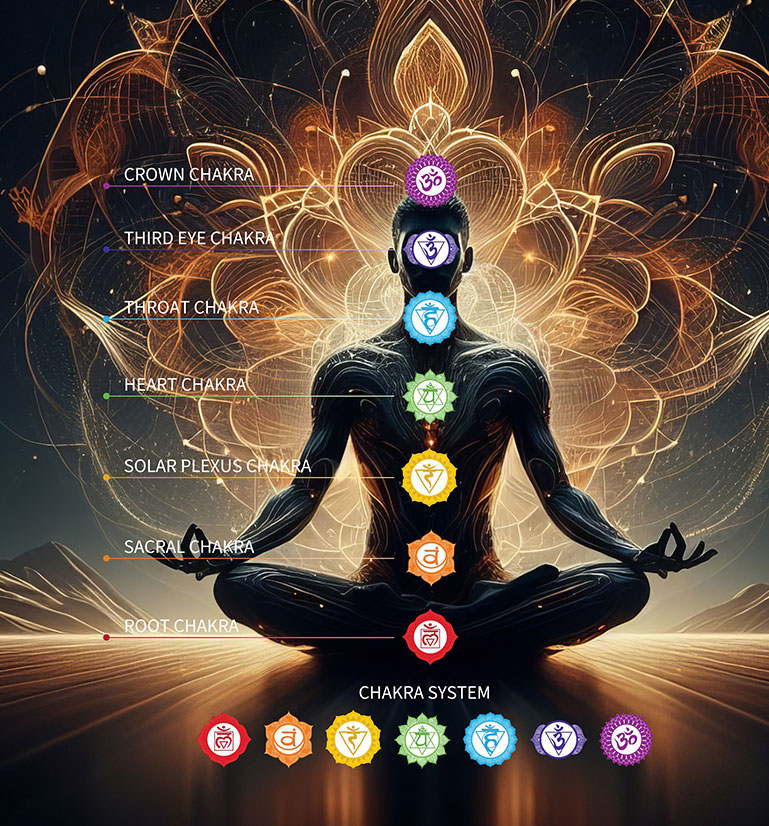
Exploring the Mystical Power
of Tibetan Singing Bowls

Tibetan singing bowls, originating from the ancient and mystical East, can be traced back to regions including ancient Tibet, Nepal, India, and other areas surrounding the Himalayas. Also known as Himalayan bowls, they have a history dating back 2000 years. Initially crafted from pure copper in ancient times, modern Tibetan singing bowls are made from a variety of metals including silver, tin, zinc, iron, lead, gold, and copper. Each metal corresponds to one of the body’s chakras, vibrating and emitting rich, deep tones when played.
Buddhist monks have long used Tibetan singing bowls in meditation practices, though their precise functions and mechanisms were not fully understood until modern research emerged. Studies indicate that the sound of the bowls can stimulate different areas of the brain, bringing the brain into theta waves. Theta waves promote heightened attention, aiding in focus and concentration on tasks while reducing distractions, thus inducing a meditative state.


Increasing research confirms that the sound of singing bowls is a low-cost, easy-to-use intervention that produces positive physiological and psychological effects. These benefits include managing uncontrolled thoughts, improving focus, reducing stress, slowing heart rate and breathing, enhancing sleep quality, and boosting immune function. In the United States, Tibetan singing bowls have become an integral part of sound therapy, wellness practices, and mindfulness meditation.
Moreover, some healthcare practitioners, including music therapists, massage therapists, and yoga instructors, incorporate Tibetan singing bowls into their treatments. The soothing resonance continues to attract individuals seeking tranquility, balance, and inner harmony in an increasingly busy world, providing them with moments of respite from the hustle and bustle of everyday life.

The fusion of ancient and modern
The MS-8 Meditation System seamlessly blends ancient meditation tools with modern technology, creating a more convenient meditation companion for contemporary individuals. Harnessing the rich, deep, and resonant tones of singing bowls, it promotes holistic well-being by offering eight beneficial bowl frequencies. Free from the need for smartphone or tablet connectivity and without the requirement of any applications, this system allows people to truly disconnect from the fragmented information overload of phones and computers, as well as the stresses of daily life, work, and study, enabling them to reconnect with their authentic selves.

The Influence of Sound Frequencies
on Human Physiology
01
Abstract
Sound frequencies are ubiquitous stimuli in daily life, yet their effects on human physiology and psychology are not widely understood. This paper aims to explore the impact of sound frequencies on the human body from a neurobiological perspective and their potential applications in medicine and therapy. Through a comprehensive analysis of relevant research, this paper demonstrates the relationship between low-frequency sounds and relaxation states, and high-frequency sounds and alertness. Additionally, it discusses the mechanisms by which sound frequencies regulate neurotransmitters and neural pathways. Finally, this paper outlines the prospects of sound frequencies in future medical and therapeutic developments.
02
Introduction
Sound, as a sensory stimulus, plays a crucial role in our daily lives. However, our understanding of the effects of sound frequencies on human physiology and psychology is still in its infancy. With advancements in neurobiology research, we are gradually uncovering the mechanisms by which sound frequencies influence the human body, offering new perspectives for their applications in medicine and therapy.
03
Effects of Low and High-Frequency Sounds on the Human Bod
Studies indicate that low-frequency sounds have a calming and relaxing effect. Such auditory stimuli can induce alpha waves in the brain, associated with a relaxed state of mind. Further experiments suggest that low-frequency sound stimulation can regulate the release of neurotransmitters such as dopamine and endorphins, thereby eliciting feelings of pleasure and relaxation. In contrast, high-frequency sounds are believed to have stimulating and invigorating effects. These auditory stimuli can activate the cerebral cortex, enhancing alertness and attention. Through experimental research, we have found that high-frequency sounds can increase alertness and vitality by activating the sympathetic nervous system. Therefore, high-frequency sounds are often used to enhance concentration, improve work efficiency, and boost learning ability. For example, bird songs, the sound of clear streams, or the tones of high-frequency singing bowls have been proven to enhance people’s attention and alertness.
04
Mechanisms
Mechanisms of Sound Frequency Regulation of Neurotransmitters: Further research indicates that sound frequencies can influence the physiological and psychological states of the human body by modulating neurotransmitter systems in the brain. Specifically, low-frequency sounds may promote the release of neurotransmitters such as dopamine and endorphins, while high-frequency sounds may affect neurotransmitter secretion by activating the sympathetic nervous system.
05
Applications
Based on an understanding of the mechanisms underlying the effects of sound frequencies, they have been widely utilized in various medical and therapeutic approaches. Sound therapy, a treatment method that utilizes sound frequencies to address mental and physical health issues, has been shown to effectively alleviate anxiety, depression, and sleep disorders.
06
Exploration
The influence of sound frequencies on the human body is a complex and diverse field that requires further research and exploration. However, through a neurobiological perspective, we have begun to uncover the mechanisms by which sound frequencies affect the human body, offering new insights into their applications in medicine and therapy. In the future, we look forward to more research on sound frequencies and their innovative applications in medicine and therapy.
Sound Baths and Sound Therapy
The practice of sound healing, with its roots spanning thousands of years in various cultures worldwide, holds a profound technological history. Participants immerse themselves in a spectrum of sound waves, emanating from a plethora of sources including gongs, singing bowls, percussion instruments, chimes, tuning forks, and even human voices (chanting om). Unlike the catchy melodies or rhythms experienced in rock concerts or symphonies, the music of sound baths comprises meticulously curated instruments and sounds, bearing significant resonance and overtones. During a sound bath session, participants typically sit on comfortable cushions, although some facilitators may request them to recline on yoga mats. Regardless of the position, participants may be instructed to close their eyes and simply listen. Through this act of shutting off visual stimuli, individuals disconnect from the external world and tune into the soundscape around them. This might include singing bowls, voices, gongs, bells, or tuning forks, generating frequencies perceivable by the ears and the brain. Different frequencies influence various organs, emotions, ailments, chakras, and traumas. Ultimately, a sound bath constitutes a subjective experience, wherein one may explore different baths or frequencies to discern what suits them best. It stands as a unique encounter, irreplaceable by other therapies, serving as an excellent complement to a myriad of therapeutic or wellness regimens.

The Interplay of Meditation, Singing Bowls,
Chakra Balancing, and Third Eye Awakening
In the realm of holistic healing and spiritual elevation, the symbiotic relationship between meditation, chakra balancing, and third eye awakening serves as the cornerstone. As an experienced meditation therapist proficient in the arts of chakra alignment and third eye activation, I aim to elucidate the intricate connections between these profound practices.
Meditation as the Gateway
Meditation serves as the portal to the inner world, fostering deep connections with the self and the universe. Through focused practice, individuals cultivate a heightened state of awareness, transcending ordinary consciousness to delve into the depths of their inner being. This heightened state of awareness is crucial for initiating the journey towards chakra balance and third eye awakening.
Singing Bowls and Chakra Balancing
Singing bowls, ancient and mystical instruments, possess unique resonant frequencies that directly influence the body’s energy system, namely the chakras. Each chakra is associated with specific colors, tones, and emotional states, and the playing of singing bowls harmonizes and activates these chakras through their specific frequencies and vibrations. As the sound waves of singing bowls traverse the body, they can alleviate energy blockages, promote free flow of energy between the chakras, thus restoring balance and health to the body. However, blockages or imbalances within the chakras may lead to various illnesses and disharmonies. Through targeted meditation techniques, practitioners can explore the chakras, identify and release blockages, restoring harmonious energy flow. By adjusting and balancing the chakras, individuals enhance vitality, creativity, and emotional resilience, paving the way for spiritual evolution.
Awakening the Third Eye for Heightened Perception
The third eye, also known as the brow chakra, is the seat of intuition, wisdom, and higher consciousness. Awakening the third eye enables individuals to perceive subtle energies, transcend the limitations of the body, and access deeper truths. Meditation practices aimed at awakening the third eye involve visualization, breathwork, and focusing attention on the center of the brow. With the opening of the third eye, individuals experience deeper intuition, clarity of vision, and profound connection with the universe.
The Power of Resonance
The playing of singing bowls not only directly influences the activity of the chakras but also induces profound resonance on physical, mental, and spiritual levels. When we listen to the sound of singing bowls in a meditative state, we are not only receiving music but also resonating with our inner energy field. This resonance can trigger internal self-healing mechanisms, assisting in releasing negative emotions, balancing moods, and elevating consciousness.
The positions of chakras and their
manifestations when imbalanced

Crown Chakra – top of the head
Physical imbalances manifest themselves as depression, inability to learn, sensitivity to light, sound and the environment. Emotional imbalances manifest themselves as confusion, prejudice and self-doubt.
Third Eye Chakra – in the middle of the eyebrows
Physical imbalances manifest themselves as headaches, blurred vision, sinus issues, seizures, hearing loss and hormonal imbalance. Emotional imbalances manifest themselves as moodiness, volatility and self-reflection.
Throat Chakra – at the throat
Physical imbalances manifest themselves as thyroid issues, sore throats, laryngitis, ear infections, neck and shoulder pain. Emotional imbalances manifest themselves as fear of communication, will-power and being out of control.
Heart Chakra – at the heart
Physical imbalances manifest themselves as asthma, heart disease, lung disease, issues with breasts, lymphatic systems and upper back and shoulder problems. Emotional imbalances manifest themselves as jealousy, abandonment, anger, bitterness and fear of loneliness.
Solar Plexus Chakra – three inches above your navel
Solar Plexus Chakra – three inches above your navel Physical imbalances manifest themselves as digestive problems, liver dysfunction, chronic fatigue, high blood pressure, diabetes, stomach ulcers and colon issues. Emotional imbalances manifest themselves as issues of personal power and self-esteem.
Sacral Chakra– Two inches below your navel
Physical imbalances manifest themselves as sexual and reproductive issues, urinary problems, kidney infections, hip pelvic and lower back pain. Emotional imbalances manifest themselves as fear of commitment to relationships, expressing emotions, fears of impotence, betrayal and addictions.
Root Chakra – Sits at the base of your spine or tailbone
The playing of singing bowls not only directly influences the activity of the chakras but also induces profound resonance on physical, mental, and spiritual levels. When we listen to the sound of singing bowls in a meditative state, we are not only receiving music but also resonating with our inner energy field. This resonance can trigger internal self-healing mechanisms, assisting in releasing negative emotions, balancing moods, and elevating consciousness.
Yoga and Tibetan Singing Bowls
Tibetan singing bowls and yoga are two ancient and potent tools for the mind, both aimed at helping individuals achieve a state of inner harmony, tranquility, and mental equilibrium. Combining them can create a deeper and more meaningful inner experience, aiding individuals in exploring the self, balancing mind and body, and fostering overall well-being and happiness. By merging the resonant tones of Tibetan singing bowls with the breath control, posture techniques, and other skills of yoga practice, the use of singing bowls can further enhance the effects of yoga, assisting in relaxation, stress reduction, and facilitating physical and mental healing and restoration. May everyone find inner peace and joy in this integrated practice.
Binaural Beats and Meditation
Binaural beats are generated by playing slightly different frequencies of sound in the left and right ears, stimulating different regions of the brain and inducing a state of relaxation or focus. Some studies suggest that listening to binaural beats tones can help individuals deepen their meditation practice, reduce anxiety, enhance focus, and promote relaxation—states sought after in meditation. However, it’s important to note that not everyone responds to binaural beats in the same way. Some individuals may find binaural beats induce bothersome tinnitus, while others may experience noticeable effects. Therefore, the best approach to determining whether to use binaural beats to deepen meditation experiences is to try them out and gauge their effectiveness firsthand.


